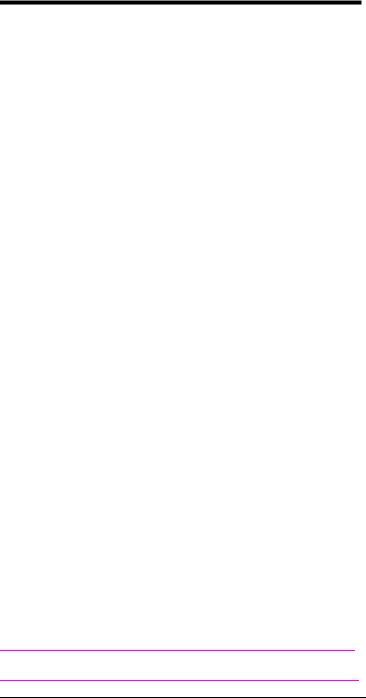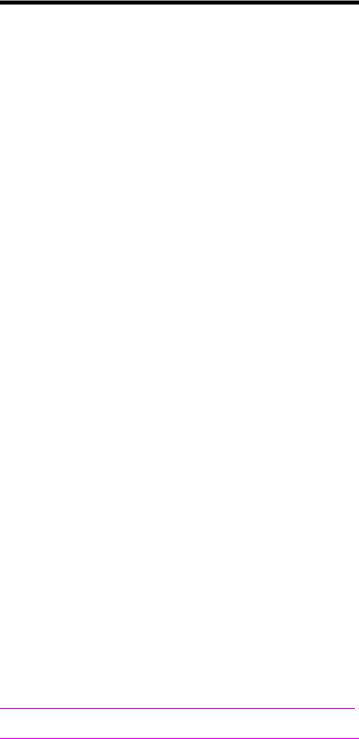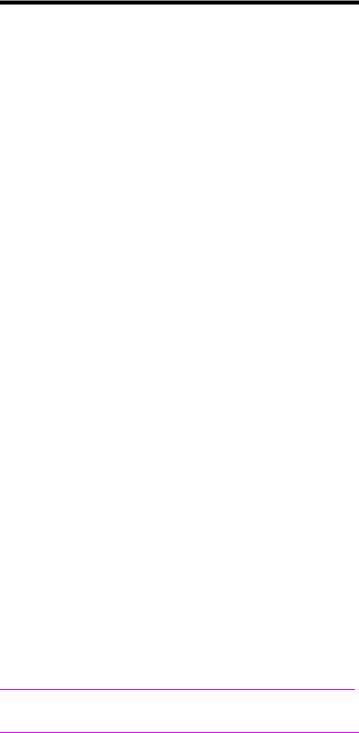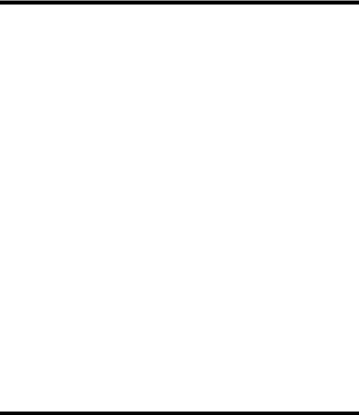Hp LASERJET 3015, COLOR LASERJET 3700, COLOR LASERJET 2500, LASERJET 1220, LASERJET 2000 PCL 5 Printer Language Technical Quick Reference Guide
...
H P P C L / P J L R e f e r e n c e S e t |
PCL 5
Printer Language
Technical
Quick Reference
Guide

Factory Default Print Environment Feature Settings (PCL)
JOB CONTROL
•NUMBER OF COPIES* = 1
•DUPLEX* = Off (Simplex)
•BINDING* = Long-Edge
•TRAY LOCK= All trays unlocked
•JOB SEPARATION = OFF
•MANUAL FEED* = OFF
•REGISTRATION (left = 0, top = 0)
•OUTPUT BIN = Upper
•UNITS OF MEASURE = 300 Units/Inch PAGE CONTROL
•PRINT DIRECTION = 0
•CHARACTER TEXT PATH DIRECTION* = 0
•TEXT PARSING METHOD* = 0
•ORIENTATION* = Portrait
•PAGE SIZE* = Letter
•PAPER (MEDIA) SOURCE = Main Source (Printer Specific)
•VERTICAL MOTION INDEX * = 8 (6 lpi)
•HORIZONTAL MOTION INDEX = 12 (10 cpi)
•TOP MARGIN = 1/2" (150 dots or 3 lines)
•TEXT LENGTH = 60 lines
•LEFT MARGIN = Left logical page boundary
•RIGHT MARGIN = Right logical page boundary
•PERFORATION SKIP = On
•LINE TERMINATION = CR=CR, LF=LF, FF=FF
FONT SELECTION**
•SYMBOL SET* = ROMAN-8 ***
•SPACING = Fixed
•PITCH = 10 cpi
•HEIGHT = 12 point
•STYLE = Upright
•STROKE WEIGHT = Medium
•TYPEFACE = Courier
•UNDERLINING MODE = Off FONT MANAGEMENT
•FONT ID = 0
•CHARACTER CODE = 0
•SYMBOL SET ID = 0
MACRO
•MACRO ID = 0
Note: Feature support varies with each printer. See the PCL 5 Comparison Guide for specific feature support information.
*For these items, select User Default values using the printer driver or control panel (or remote control panel for LaserJet 4L, 5L, and 5P).
**The font characteristics are determined by the default font. The default font can be the factory default font or the user selected default font from the control panel or from a font cartridge with a default font.
***PC-8 is the default symbol set for the LaserJet 5L and 5Si/5SiMx printers.
1

Factory Default Print Environment Feature Settings (PCL)
(continued)
PRINT MODEL
•SOURCE TRANSPARENCY MODE = 0 (Transparent)
•PATTERN TRANSPARENCY MODE = 0 (Transparent)
•CURRENT PATTERN = Solid (Black)
•PATTERN REFERENCE POINT = 0,0
•PATTERN ROTATION = 0
RECTANGULAR AREA FILL
•HORIZONTAL RECTANGLE SIZE = 0
•VERTICAL RECTANGLE SIZE = 0
•PATTERN (AREA FILL) ID = 0 RASTER GRAPHICS
•RESOLUTION = 75 dpi
•PRESENTATION = 3
•COMPRESSION MODE = 0
•LEFT GRAPHICS MARGIN = 0
•RASTER WIDTH = Logical Page
•RASTER HEIGHT = N/A
TROUBLESHOOTING COMMANDS
•END-OF-LINE WRAP = OFF
•DISPLAY FUNCTIONS = OFF STATUS READBACK
•CURRENT LOCATION TYPE = 0
•CURRENT LOCATION UNIT = 0
Factory Default Print Environment Feature Settings
(HP-GL/2)
LINE AND FILL GROUP
•LINE TYPE = Solid
•LINE TYPE REPEAT LENGTH = 4% of the diagonal distance from P1 to P2.
•LINE CAP = Butt
•LINE JOIN = Mitered
•MITER LIMIT = 5
•PEN WIDTH = 0.35mm
•PEN WIDTH SELECTION MODE = Metric
•SELECTED PEN = No pen
•FILL TYPE = Solid (bi-directional)
•USER-DEFINED LINE TYPE = Eight standard line types
•ANCHOR CORNER = (0,0) plotter units
•USER-DEFINED FILL TYPES = Solid fill
•TRANSPARENCY MODE = On (transparency)
•SCREENED VECTOR = No screening
2

Factory Default Print Environment Feature Settings
(HP-GL/2) (continued)
CONFIGURATION AND STATUS GROUP
•SCALE MODE = Off
•WINDOW = PCL default picture frame (PCL default logical page, less 1/2 inch at the top and bottom)
•COORDINATE SYSTEM ORIENTATION = Same as PCL default logical page
•P1,P2 Lower left, upper right corners of picture frame
CHARACTER GROUP
•SYMBOL SET = Roman-8
•FONT SPACING = Fixed
•PITCH = 10 cpi
•HEIGHT = 12 point
•POSTURE = Upright
•STROKE WEIGHT = Medium
•TYPEFACE = HP-GL/2 stick
•CHARACTER DIRECTION = Horizontal
•CHARACTER DIRECTION MODE = Absolute
•CHARACTER SIZE = Size transformation off
•CHARACTER SIZE MODE = Absolute
•CHARACTER WIDTH = N/A
•CHARACTER HEIGHT = N/A
•CHARACTER SLANT = 0
•EXTRA HORIZONTAL SPACE = 0
•EXTRA VERTICAL SPACE = 0
•CHARACTER FILL MODE = No edging, solid fill
•LABEL ORIGIN = 1
•LABEL TERMINATOR = Etx
•TRANSPARENT DATA MODE = Off
•PRIMARY FONT ID = 0
•SECONDARY FONT ID = 0
•SCALABLE OR BITMAP FONT = Select scalable only
VECTOR GROUP
•PLOTTING MODE = Absolute
•PEN STATE = Up
POLYGON GROUP
•POLYGON BUFFER = Cleared
•POLYGON MODE = Off
3

Job Control
Universal Exit Language
Causes the printer to exit the current language and return control to PJL.
? % – 1 2 3 4 5 X
Configuration (AppleTalk)
Allows the user to configure the printer I/O to receive PCL jobs over AppleTalk I/O.
?& b # W [Key]<sp>[value]
#= Number of bytes of [key]/[value] data (count space <sp>).
Printer Reset
Restores the User Default Environment, deletes temporary fonts and macros, and prints any remaining data.
? E
Number of Copies
Prints the specified number (#) of copies of each page.
?& l # X
#= Number of copies (1 to 99 for III/IIID; 1 to 32,767 for IIISi, 4 family and 5 family)
Simplex/Duplex Print
Prints front side of a page or both sides (front and back - in either of two binding modes).
?& l # S
#= 0 - Single side (Simplex)
1- Duplex, long-edge binding
2- Duplex, short-edge binding
Left (Long-Edge) Offset Registration
Adjusts the position of the logical page across the width of the page.
?& l # U
#= Number of decipoints (1/720 inch)
[+ or – specifies the plus or minus move direction (for example, # = –10).]
Top (Short-Edge) Offset Registration
Adjusts the position of the logical page across the length of the page.
?& l # Z
#= Number of decipoints (1/720 inch)
[+ or – specifies the plus or minus move direction (for example, # = –10).]
Note: The printer ignores any commands sent to it that it does not support.
4

Job Control (continued)
Duplex Page Side Selection
Prints the logical page on the specified physical page side.
?& a # G
#= 0 - Select next side 1 - Select front side 2 - Select back side
If a non-duplex printer receives this command, it performs a page eject.
Job Separation
Toggles the printer's job separation mechanism.
? & l 1 T
Output Bin
Selects the output paper bin for paper output.
?& l # G
#= 0 - Automatic selection
1- Upper Output Bin (for the LaserJet 5Si, printer top/face-down bin—bin #1)
2- Rear Output Bin (for the LaserJet 5Si, printer left/face-up bin—bin #2; this bin is not available
when the High Capacity Output (HCO) is attached) 3 - Selects Bin #3 (HCO face-up bin)
4- Selects Bin #4 (HCO #1 face-down bin)
5- Selects Bin #5 (HCO #2 face-down bin)
6- Selects Bin #6 (HCO #3 face-down bin)
7- Selects Bin #7 (HCO #4 face-down bin)
8- Selects Bin #8 (HCO #5 face-down bin)
9- Selects Bin #9 (HCO #6 face-down bin)
10- Selects Bin #10 (HCO #7 face-down bin)
11- Selects Bin #11 (HCO #8 face-down bin)
Unit of Measure
Establishes the unit of measure for the PCL unit.
?& u # D
#= Number of units/inch (96, 100, 120, 144, 150, 160, 180, 200, 225, 240, 288, 300, 360, 400, 450, 480, 600, 720, 800, 900, 1200, 1440, 1800, 2400, 3600, 7200)
5

Page Control
Page Size
Designates the physical paper size which in turn defines the logical page.
?& l # A
#= 1 - Executive (7.25" x 10.5") 2 - Letter (8.5" x 11")
3 - Legal (8.5" x 14")
6 - Ledger (11" x 17")
25 - A5 paper (148mm x 210mm)
26 - A4 paper (210mm x 297mm)
27 - A3 (297mm x 420mm)
45 - JIS B5 paper (182mm x 257mm)
46 - JIS B4 paper (250mm x 354mm)
71 - Hagaki postcard (100mm x 148mm)
72 - Oufuku-Hagaki postcard (200mm x 148mm)
80 - Monarch Envelope (3 7/8" x 7 1/2")
81 - Commercial Envelope 10 (4 1/8" x 9 1/2") 90 - International DL (110mm x 220mm)
91 - International C5 (162mm x 229mm)
100 - International B5 (176mm x 250mm)
101 - Custom (size varies with printer)
Correct paper tray must be installed for selected paper size.
Page Length (Obsolete—see Paper Size)
Selects the logical page length in lines (one logical page per physical page)
?& l # P
#= Number of Lines
Paper (Media) Source
Designates one of four paper sources for paper feed.
?& l # H
#= 0 - Print current page (paper source remains unchanged) 1 - Feed paper from main paper source
2 - Feed paper from manual input
3 - Feed envelope from manual input
4 - Feed paper from alternate paper source
5 - Feed from optional large paper source
6 - Feed envelope from envelope feeder *
7 - Autoselect
8 - Feed paper from Tray 1 (right side tray) 20 - 39 - High Capacity Input (HCI) Trays 2-21
* Must be used in conjunction with Paper Size.
6

Page Control (continued)
Page Orientation
Designates the logical page position with respect to the physical page.
?& l # O
#= 0 - Portrait
1 - Landscape
2 - Reverse Portrait
3 - Reverse Landscape
Print Direction
Rotates the logical page coordinate system counterclockwise in 90 degree increments with respect to the orientation of the current logical page.
?& a # P
#= Degrees of rotation (0, 90, 180, 270)
Character Text Path Direction
Specifies the direction text is printed on the page, providing a means of printing using either a horizontal or vertical text path.
?& c # T
#= 0 - Horizontal printing
= –1 - Vertical rotated printing
Text Parsing Method
Specifies PCL parsing method as either 1-byte or 2-byte characters codes.
?& t # P
#= 0, 1 - All character codes processed as one-byte characters
=21 - Character codes processed as two-byte characters (see PCL 5 Comparison Guide)
=31 - Character codes processed as two-byte characters (see PCL 5 Comparison Guide)
=38 - Characters codes processed as two-byte characters (see
PCL 5 Comparison Guide)
Left Margin
Sets the left margin to the left edge of the specified column.
?& a # L
#= Column number
Right Margin
Sets the right margin to the right edge of the specified column.
?& a # M
#= Column number
7

Page Control (continued)
Top Margin
Designates number of lines between top of logical page to top of text area.
?& l # E
#= Number of lines
Clear Horizontal Margins
Resets left and right margins to their default settings.
? 9
Horizontal Motion Index (HMI)
Designates the distance between columns. (The value field # is valid to 4 decimal places.)
?& k # H
#= Number of 1/120 inch increments
Vertical Motion Index (VMI)
Designates the distance between rows. (The value field # is valid to 4 decimal places.)
?& l # C
#= Number of 1/48 inch increments between rows
Line Spacing
Sets the number of lines printed per inch (an alternate method for designating VMI).
?& l # D
#= 1 - 1 line/inch 2 - 2 lines/inch 3 - 3 lines/inch 4 - 4 lines/inch 6 - 6 lines/inch
8 - 8 lines/inch
12 - 12 lines/inch
16 - 16 lines/inch
24 - 24 lines/inch
48 - 48 lines/inch
Text Length
Designates the length of the text area in lines.
?& l # F
#= Number of lines
Perforation Skip
Causes printing to skip from the end of the text area to the top of the next text area (top margin of new page).
?& l # L
#= 0 - Disabled 1 - Enabled
8

Cursor Positioning
Cursor positioning can be either absolute or relative. Absolute positioning specifies the cursor move distances referenced from the left edge of the logical page and the top margin. Relative positioning specifies cursor move distances referenced from the current cursor position. Relative moves are indicated by using signed numbers (e.g. # = +15 or –122); absolute moves are indicated by unsigned numbers (e.g. # = 15 or 122).
Horizontal Cursor Positioning (in Columns)
Moves the cursor to a new column on the current line (column width determined by current HMI setting).
?& a # C
#= Column number
Horizontal Cursor Positioning (in Decipoints)
Moves the cursor to a new position along the x-axis.
?& a # H
#= Decipoint position (1/720 inch), valid to 2 decimal places.
Horizontal Cursor Positioning (PCL units)
Moves the cursor to a new position along the x-axis.
?* p # X
#= Number of PCL units
Horizontal Cursor Positioning Control Codes
CR - Carriage-Return
Moves the cursor to the left margin on the current line.
(Operation of CR may be modified—see Line Termination command.)
SP - Space
Moves the cursor one column right on the current line for fixed-space font or moves the cursor the HMI distance for proportional fonts when space is a non-printing character.
BS - Backspace
Moves the cursor left, the distance of the last printed character, on the current line for fixed-space fonts. For proportionally-spaced fonts, backspace moves the cursor back along the current line the distance required to center the overstrike character over the last printed character. Subsequent BS command moves the width of the last printed character.
HT - Horizontal Tab
Moves the cursor to the next tab stop on the current line. (Tab stops are set every 8th column.)
9

Cursor Positioning (continued)
Vertical Cursor Positioning (Rows)
Moves the cursor to a new row in the same column (row distances are determined by the VMI setting).
?& a # R
#= Row number
Vertical Cursor Positioning (Decipoints)
Moves the cursor to a new vertical position along the y-axis.
?& a # V
#= Decipoint position (1/720 inch), valid to 4 decimal places.
Vertical Cursor Positioning (PCL units)
Moves the cursor to a new dot position along the y-axis.
?* p # Y
#= Number of PCL units
Half Line-Feed
Moves the cursor to the same character position one-half line down (distance moved depends on current VMI).
? =
Vertical Cursor Positioning Control Codes
LF - Line Feed
Moves the cursor to the same horizontal position on the next line.
FF - Form Feed
Moves the cursor to the same horizontal position at the top of the next text area.
Line Termination
Controls the way the printer interprets CR, LF, and FF control codes.
? & k # G
# = 0 |
- CR = CR, |
LF = LF, |
FF = FF |
1 |
- CR = CR+LF, |
LF = LF, |
FF = FF |
2 |
- CR = CR, |
LF = CR+LF, |
FF = CR+FF |
3 |
- CR = CR+LF, |
LF = CR+LF, |
FF = CR+FF |
Push/Pop Cursor Position
Allows the cursor position to be stored and recalled for later use. (Up to 20 positions may be pushed onto the stack)
?& f # S
#= 0 - Push (Store cursor position) 1 - Pop (Recall a cursor position)
10

Font Selection
Any number of fonts may be printed per page, limited only by memory.
Symbol Set
Designates the set of symbols or characters contained in a font.
?( ID Primary
?) ID Secondary
ID = Symbol Set identifier
Common examples:
ID = 8M |
- HP Math-8 |
0N |
- ISO 8859-1 Latin 1 |
8U |
- HP Roman-8 |
0O |
- OCR A |
10U |
- PC-8 |
1E |
- ISO 4: United Kingdom |
1G |
- ISO 21: German |
1U |
- HP US Legal |
0U |
- ASCII |
19U |
- Windows ANSI |
See Table C-1 in the PCL 5 Comparison Guide for more symbol sets.
Spacing
Designates either a fixed or proportionally spaced font.
? ( s # P - Primary
? ) s # P - Secondary
# =0 - Fixed spacing
1 - Proportional spacing
Pitch
Designates the horizontal spacing of a fixed spaced font in terms of the number of characters per inch.
?( s # H - Primary
?) s # H - Secondary
#= Pitch in characters/inch
Height (Point Size)
Designates the height of the font in points.
?( s # V - Primary
?) s # V - Secondary
#= Height in points
11

Font Selection (continued)
Style
Designates the font style.
?( s # S - Primary
?) s # S - Secondary
#= 0 - Upright 1 - Italic
4 - Condensed
5 - Condensed Italic
8 - Compressed, Extra Condensed
24 - Expanded
32 - Outline
64 - Inline
128 - Shadowed
160 - Outline Shadowed
Stroke Weight
Designates the thickness or weight of the stroke that composes the characters of a font.
?( s # B - Primary
?) s # B - Secondary
# = -7 |
- Ultra thin |
1 |
- Semi Bold |
-6 |
- Extra Thin |
2 |
- Demi Bold |
-5 |
- Thin |
3 |
- Bold |
-4 |
- Extra Light |
4 |
- Extra Bold |
-3 |
- Light |
5 |
- Black |
-2 |
- Demi Light |
6 |
- Extra Black |
-1 |
- Semi Light |
7 |
- Ultra Black |
0 |
- Medium |
|
|
Typeface Selection
Designates the design of the font.
? ( s # T |
- |
Primary |
|
|
? ) s # T |
- |
Secondary |
|
|
# = 0 - Line Printer |
8 |
- Prestige |
||
3 |
- Courier |
4099 |
- Courier (Scalable) |
|
4 |
- Helvetica |
4101 |
- CG Times |
|
6 |
- Gothic |
4148 |
- Univers |
|
7 |
- Script |
16602 |
- Arial |
|
See Table C-2 and C-3 in the PCL 5 Comparison Guide for more typeface values.
Font Selection by ID #
Selects a soft font using its specific ID #.
?( # X - Designates soft font as primary
?) # X - Designates soft font as secondary
#= Font Identification number (ID #; 0 through 32767)
12

Font Selection (continued)
Select Default Font
Sets all font characteristics (except orientation) to those of the default font.
?( 3 @ Default primary font characteristics
?) 3 @ Default secondary font characteristics
Transparent Print Data
Provides printing access to all characters in a font including those defined as unprintable.
?& p # X [transparent data ]
#= Number of bytes of transparent print data.
Underline
Controls automatic text underlining.
?& d # D
#= 0 - Underline On
3 - Floating Underline On
? & d @ - Underline Off
13

Font Management
Font ID #
Specifies an identification number (ID #) for use in subsequent font management commands.
?* c # D
#= ID # (0 through 32767)
Font Control
Provides the means for manipulating soft fonts within the printer.
?* c # F
#= 0 - Delete all soft fonts
1 - Delete all temporary soft fonts
2 - Delete soft font (last ID specified)
3 - Delete Character Code (last ID and character code) 4 - Make soft font temporary (last ID specified)
5 - Make soft font permanent (last ID specified)
6 - Copy/Assign current invoked font as temporary
Alphanumeric ID
Specifies alphanumeric String IDs for fonts, macros, and media types. Specifies media selection by the type of media and supports enhancements for the printer disk drive.
?& n # W [operation][string]
#= Number of bytes of string data
Operations
0 - Set the current Font ID to the given String ID.
1 - Associates current Font ID to font with supplied String ID.
2 - Selects the font referred to by the String ID as primary.
3 - Selects the font referred to by the String ID as secondary.
4 - Sets the current Macro ID to the String ID.
5 - Associates the current Macro ID to the supplied String ID.
20 - Deletes the font association named by the current Font ID.
21 - Deletes the macro association named by the current Macro ID.
100 - Media select
Note: See the PCL 5 Printer Language Technical Reference Manual for additional information about the Font Descriptor command and the Character Descriptor command data fields.
14

User-Defined Symbol Set
Symbol Set ID Code
Assigns an identification code to a user-defined symbol set.
?* c # R
#= Symbol set ID code.
Define Symbol Set
Downloads symbol set definition data for a user-defined symbol set.
?( f # W [symbol set definition data]
#= Number of symbol set definition bytes.
Symbol Set Control
Provides a means for manipulating user-defined symbol sets.
?* c # S
#= 0 - Delete user-defined symbol sets (temporary
and permanent)
1 - Delete all temporary symbol sets
2 - Delete symbol set (last symbol set ID code specified) 4 - Make symbol set temporary (last symbol set
ID code specified)
5 - Make symbol set permanent (last symbol set ID code specified)
Soft Font Creation
Font Descriptor
Downloads the font descriptor to the printer.
?) s # W [ font descriptor data ]
#= Number of font descriptor data bytes
Character Code
Establishes the decimal character code that will be associated with the next character downloaded or deleted.
?* c # E
#= Decimal character code
Character Descriptor/Data
Downloads the character descriptor and character data.
?( s # W [binary data bytes]
#= Number of binary data bytes
15
